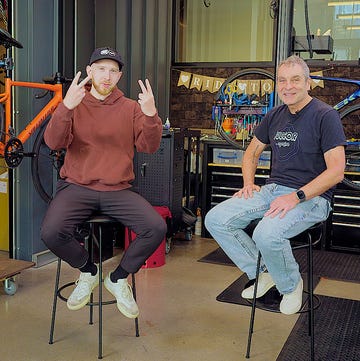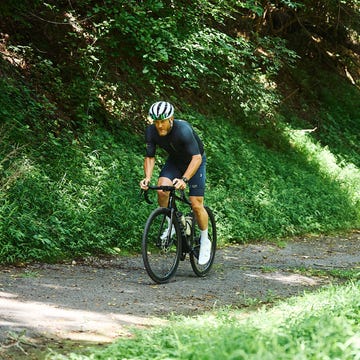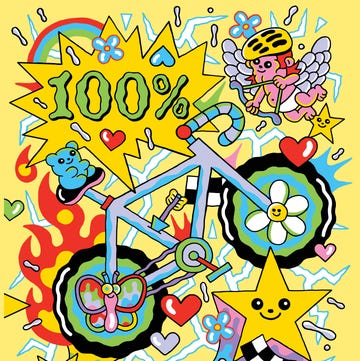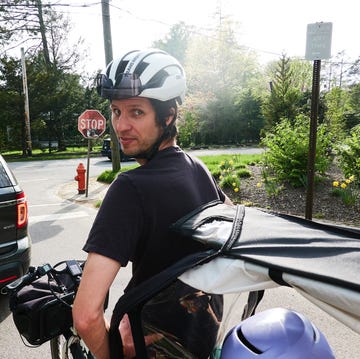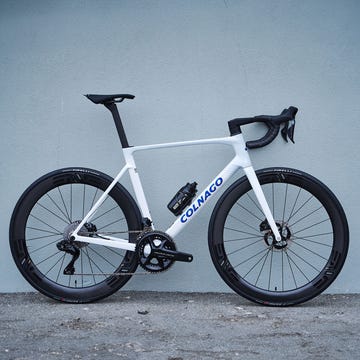Neck pain is hard for most of us to avoid without taking preventative action. Between desk jobs, time spent sitting in front of computers, and the modern appendage we all now call “phones,” a forward leaning head posture, often colloquially referred to as “tech neck,” has become a bonafide health condition. The prevalence of this postural distortion and the associated neck pain can be even more common in cyclists.
One of the reasons for this is that over time the muscles in the front of our necks get weaker the more time we spend looking down as we do when we’re looking at our phone, while the muscles in the back of our necks are working overtime holding the weight of our head up in that forward head posture.
If this not-so-great postural habit becomes a long-term thing (which, let’s be honest, for most of us it is) our necks can develop muscle imbalances that can throw off our entire posture and cause neck pain and headaches. A tight neck also makes it difficult to look over your shoulder to look out for drivers while riding, which is essential for staying safe out on the road.
And if you're me, those overly tight posterior neck muscles also cause hand tingling and numbness, so it’s something I personally have to really stay on top of.
In the quest of keeping my neck happy, I’ve tried all sorts of myofascial tools and products that claim they relieve neck tightness, aches and pains. Some of these products have been marginally helpful, and some of them have been complete duds providing little and in a few cases zero relief.
However, on the flip side I have discovered a handful of products designed to address neck pain that are absolute gems. These items relieve my neck pain so well that I tell every single one of my clients about them during their assessment before we even start training, since improved posture is often one of their goals because it’s crucial for good form, whether in the gym or on the bike. Relieving neck tension is an important component in correcting less than ideal posture.
I use each of these tools a few times a week, either all at once if I have a chunk of free time, or spacing them out over the course of several days, which is usually more doable with a busy schedule. I recommend following the steps in the order they’re listed below, whether you go through this list all at once or break it out over the course of a week.
My typical weekly “schedule” often looks something like this: Monday is “neck stretcher day” , Tuesday “trigger point day” , Thursday is “heat therapy day” , and Friday is the day I stretch my entire upper back and melt away a week of sitting at a desk.
Step 1: Relax and Stretch Your Neck
Research has shown that we may lose the natural curvature of our neck (cervical curvature) over the course of our lives, and for many this goes hand in hand with a forward head posture a.k.a. tech neck. A 2019 meta-analysis found a strong link between forward head posture and neck pain.
This somewhat weird-looking neck stretcher feels like the antidote to a day spent looking down at a laptop. I use it as to release tension and gently provide a bit of traction for my neck, restoring the cervical curve. Set aside 10 to 15 minutes to use this tool to get the most benefit.
Step 2: Trigger Point Therapy
Have you ever had a professional massage during which you’re laying on your back and the massage therapist cradles the back of your head, finding and applying pressure to the tense spots at the base of your skull?
This is known as the suboccipital release technique. One of the benefits of this technique is to release trigger points at the base of the skull. In a 2024 paper published in the Journal of Clinical Medicine found that it can help alleviate issues like neck tension, jaw pain, headaches and even has a relaxing effect on brain waves.
This tool replicates that release technique—at least as much as is possible for an inanimate object to replace human hands and the skill of a massage therapist or physical therapist.
Specially shaped and positioned nodes let gravity do the work, resulting in a gentle suboccipital release. It’s important to note that the tool does not put direct pressure on your spine, which is a good rule of thumb regardless of what kind of self-myofascial release tools you’re using.
Step 3: Heat Therapy
This might be my clients’ favorite among the whole bunch: a heating pad that wraps around your neck and shoulders like a warm shawl of bliss. This one is slightly weighted so that it lays flush against your skin, so your muscles can absorb the pain relieving effects of heat therapy.
A 2022 systemic review and meta-analysis in Archives of Physical Medicine and Rehabilitation found that in addition to helping with muscle pain relief, applying heat can positively affect muscle strength and range of motion.
Aim for at least ten minutes of wearing this heating pad to get the tension-relieving benefits, though I’d bet that you’ll want to use it for much longer than that!

Natascha Grief is Bicycling’s Health & Fitness Editor. She started in the cycling industry as a bike mechanic a couple of decades ago, earning a couple pro-mechanic certifications and her USA Cycling Race Mechanic license. She went on to apprentice for framebuilder Brent Steelman in her hometown of Redwood City, California before spending several years working for both large and not-so-large cycling brands. She then switched gears and industries to earn multiple personal training certifications while honing her skills as a trainer and coach, specializing in functional training, corrective exercise, and body positive personal training. She began contributing regularly to Runner’s World and Bicycling as a freelance writer in 2020, and joined the editorial staff of Bicycling in 2022.







